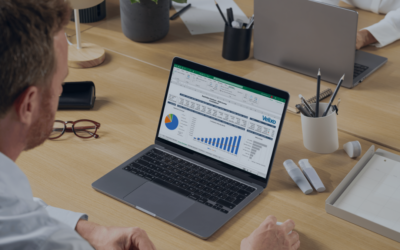Enterprise resource planning (ERP) systems are essential tools for modern businesses to streamline their operations, automate processes, and improve their overall efficiency. However, implementing ERP software can be a major investment for any company, and the vendor’s chosen ERP software pricing models can significantly affect the overall cost.
It is crucial for companies to evaluate the different pricing strategies offered by ERP vendors carefully to ensure they are getting the best value for their money. In this post, we’ll explore some of the most popular pricing models available today, their pros and cons, and some factors that determine software cost.
Common ERP Software Pricing Models
Taking the time to do your research and compare different ERP software can really pay off. With the right system, you can drastically improve business operations, promote alignment between teams, and more. Here are some of the most popular ERP software pricing models available today.
Perpetual Licensing
Perpetual licensing is among the most common pricing strategies used by ERP vendors. With this model, the company pays an upfront fee for the software license, which is usually based on the number of users or level of functionality required. After purchasing the license, the company owns the software and maintains and upgrades it.
Pros:
- It provides a one-time, upfront cost that can be easier to budget for than ongoing subscription fees.
- Companies have full control over the software and can customize it as needed.
- This model may be more cost-effective in the long term if the company plans to use the ERP system for an extended period.
Cons:
- Upfront costs can be high, making it difficult for smaller companies to afford.
- Companies maintain and upgrade the software, which can be costly and time-consuming.
- The perpetual license does not include ongoing support or upgrades, possibly leading to additional costs.
Subscription-Based
Subscription-based pricing is becoming increasingly popular with ERP vendors. With this model, companies pay a recurring fee for access to the software, usually on a monthly or annual basis. The subscription fee typically includes maintenance, support, and upgrades.
Pros:
- The upfront costs are lower, making it easier for smaller companies to afford.
- The subscription fee includes ongoing support and upgrades, which can save time and money on maintenance costs.
- It provides greater flexibility, allowing companies to scale up or down as needed.
Cons:
- Over time, subscription fees can add up and may end up costing more than a perpetual license.
- Companies do not own the software, and if they cancel the subscription, they lose access to the system.
- The subscription fee may increase over time, resulting in unexpected costs.
Usage-Based
Usage-based pricing is a model that charges based on the number of transactions, data storage, or other metrics. This model is typically used by cloud-based ERP systems.
Pros:
- It allows companies to pay only for what they use, making it a cost-effective option for companies with fluctuating demand.
- It provides flexibility and scalability so that companies have greater control over what they pay for and use.
Cons:
- The costs can be unpredictable, making it challenging to budget accurately.
- The complicated nature of this pricing structure can make it difficult for customers to understand the true cost of using it.
- Companies may end up paying more if they exceed usage limits.
Tiered Pricing
Tiered pricing is a pricing model that offers different levels of functionality at different price points. With this model, companies can choose the level of functionality that best suits their needs and budget.
Pros:
- It offers flexibility, allowing companies to choose the level of functionality they need and can afford.
- It allows companies to upgrade to a higher tier as their needs and budget grow.
Cons:
- As with usage-based models, the pricing structure can be difficult to understand, and many companies may struggle to understand the actual cost of using the system.
- Companies may end up paying for functionality they don’t need or use.
- The cost of upgrading to a higher tier may be significant.
Factors That Influence ERP Pricing
The pricing of an ERP system can vary widely, depending on several things. These factors include:
Size of the Company
The size of the company is one of the most significant factors that influence ERP pricing. Larger companies with more extensive operations and complex processes will require more extensive and sophisticated ERP systems. As a result, they often need to pay more for software licenses and customization services.
Level of Customization
The level of customization required is another significant factor in ERP pricing. Companies with unique business processes or specific industry requirements need to customize the software to fit their needs. Customization can involve programming, database design, and integration with other systems, which can increase the cost of implementing the ERP system.
Functional Requirements
The functional requirements of the ERP system also affect pricing. Companies that need advanced functionality, such as supply chain management, financials, or customer relationship management, typically pay more for their software and customization services. Software can be more expensive for companies that require multiple modules than those that only require a single module.
Implementation Costs
Implementation costs can include hardware, software, and consulting fees. The complexity of the implementation process also affects the amount companies pay for the system. For example, companies that need to integrate the ERP system with existing software or migrate data from legacy systems will require more extensive implementation services.
Maintenance and Support Costs
ERP software requires ongoing maintenance and support to ensure it continues to function correctly. The cost of maintenance and support services can vary widely between ERP vendors, and organizations should consider these costs when evaluating the total cost of ownership of the ERP system.
ERP Vendor
Some ERP vendors are more expensive than others, and businesses should consider the vendor’s reputation, expertise, and support services when evaluating the cost of the ERP system. It’s also important to note that some vendors require companies to purchase additional software or services, which can increase the cost of the ERP system.
Looking For an Expert Vendor? We Can Help.
With the number of solutions available on the market today, finding the right ERP system for your business can be tricky. There’s a lot to consider when evaluating pricing models, which is why organizations should partner with a trusted vendor to meet their software needs.
Intelligent Technologies sells and supports popular ERP solutions for SMBs, including Acumatica Cloud-Based ERP and Microsoft Dynamics GP. Get in touch with us today to schedule a consultation and get your ERP pricing questions answered by an expert!



